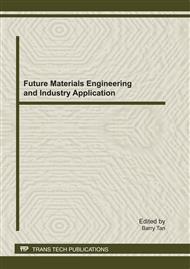[1]
M. Schrader and H. D. Fahimi, Peroxisomes and oxidative stress, Biochimica et Biophysica Acta, vol. 1763, pp.1755-1766, December (2006).
DOI: 10.1016/j.bbamcr.2006.09.006
Google Scholar
[2]
M. Zamocky, P. G. Furtmuller, and C. Obin, Evolution of catalases from bacteria to humans, Antioxidants & Redox Signaling, vol. 10, no. 9, pp.1527-1548, September (2008).
DOI: 10.1089/ars.2008.2046
Google Scholar
[3]
E. M. Trost and L. Fische, Minimization of by-product formation during D-amino acid oxidase catalyzed racemate resolution of D/L-amino acids, Journal of Molecular Catalysis, B: Enzymatic, vol. 19-20, pp.189-195, December (2002).
DOI: 10.1016/s1381-1177(02)00166-2
Google Scholar
[4]
M. Yoshimoto, Y. Miyazaki, and Y. Kudo, Glucose oxidation catalyzed by llposomal glucose oxidase in the presence of catalase-containing liposemes, Biotechnol Prog, vol. 22, pp.704-709, May-June (2006).
DOI: 10.1021/bp050416m
Google Scholar
[5]
X. G. Duan, W. Shen, Y. L. Li, Z. M. Rao, X. M. Tang, H. Y. Fang, et al, Construction of recombinant thermostable catalase engineering strain and optimization of its fermentation condition, Journal of Food Science and Biotechnology, vol. 25, no. 2, pp.74-78, (2006).
Google Scholar
[6]
F. Fang, Y. Li , G. C. Du , J. Zhang, and J. Chen, Thermo-alkali-stable catalase from thermoascus aurantiacus and its potential use in textile bleaching process, Chinese Journal of Biotechnology, vol. 20, no. 3, pp.423-428, May (2004).
Google Scholar
[7]
H. Luo, H. M. Yu , Q. Li, and Z. Y. Shen, Rapid cloning and expression of glutaryl-7-aminocephalosporanic acid acylase genes from soil samples, Tsinghua Science and Technology, vol. 10, no. 5, pp.529-534, October (2005).
DOI: 10.1016/s1007-0214(05)70113-9
Google Scholar
[8]
S. Loprasert and S. Negoro, Cloning nucleotide sequence and exepression in E. coli of the Bacillus stearothermophilus peroxidase gene, Journal of Bacteriology, vol. 171, no. 9, pp.4871-4875, September (1989).
DOI: 10.1128/jb.171.9.4871-4875.1989
Google Scholar
[9]
H. Aurelio, B. Lorena, M. Renata, Z. Olga, C. Felipe, F. L. Roberto et al, Thermus thermophilus as a Cell Factory for the Production of a Thermophilic Mn-Dependent Catalase Which Fails To Be Synthesized in an Active Form in Escherichia coli., Applied and Environmental Microbiology, vol. 70, pp.3839-3844, July (2004).
DOI: 10.1128/aem.70.7.3839-3844.2004
Google Scholar
[10]
R. F. Jr. Beers, I.W. Sizer, A spectrophotometric method for measuring the breakdown of hydrogen peroxide by catalase, Biol. Chem., vol. 195, p.276–287, March (1952).
DOI: 10.1016/s0021-9258(19)50881-x
Google Scholar
[11]
A. G. Hildebrandt, I. Roots, Reduced nicotinamide adenine dinu-cleotide phosphate (NADPH)-dependent formation and breakdown of hydrogen peroxide during mixed function oxidation reaction in liver microsomes, Arch. Biochem. Biophys, vol. 171, p.385–397, December (1975).
DOI: 10.1016/0003-9861(75)90047-8
Google Scholar
[12]
J. F. Davidson, B. Whyte, P. H. Bissinger, and R. H. Schiestl, Oxidative stress is involved in heat-induced cell death in Saccharomyces cerevisiae, Proceeding of the National Academy of Sciences of the United States of America, vol. 93, no. 10, pp.5116-5121, May (1996).
DOI: 10.1073/pnas.93.10.5116
Google Scholar
[13]
T. Savitr, A. Satoshi, M. Kouji, S. Yasuichiro, S. Mikiko, Y. Tetsuya, et al, Revised sequence and activity of Bacillus stearothermophilus catalase I (formerly peroxidase), Journal of Fermentation and Bioengineering, vol. 74, no. 4, pp.234-237, December (1992).
DOI: 10.1016/0922-338x(92)90117-d
Google Scholar
[14]
A. Fiedurek and A. Gromada, Selection of biochemical mutants of Aspergillus niger with enhanced catalase production, Appl. Microbiol. Biotechnol, vol. 47, no. 3, p.313–316, March (1997).
DOI: 10.1007/s002530050933
Google Scholar
[15]
P. C. Loewen, B. L. Triggs, C. S. George, and B. E. Hrabarchuk, Genetic mapping of katG, a locus that affects synthesis of the bifunctional catalase-peroxidase hydroperoxidase I in Escherichia coli, J Bacteriol, vol. 162, no. 2, pp.661-667, May (1985).
DOI: 10.1128/jb.162.2.661-667.1985
Google Scholar
[16]
V. Federica, M. Flavia, G. Luciano, Optimization of glutaryl-7-aminocephalosporanic acid acylase expression in E. coli, Protein Expr Purif, vol. 61, no. 2, pp.131-137, October (2008).
DOI: 10.1016/j.pep.2008.05.010
Google Scholar
[17]
C. Kobayashi, Y. Suga, K. Yamamoto, T. Yomo, K. Ogasahara, K. Yutani, et al, Thermal conversion from low- to high-activity forms of catalase I from Bacillus stearothermophilus, Biol Chem, vol. 272, no. 37, pp.23011-23016, September (1997).
DOI: 10.1074/jbc.272.37.23011
Google Scholar


